Research Proposal: Improving Dual Diagnosis Treatment Services
VerifiedAdded on 2020/05/28
|27
|7756
|176
Report
AI Summary
This research proposal investigates the improvement of treatment services for patients with dual diagnosis, a condition characterized by co-occurring mental illness and substance abuse disorders. The study aims to explore the current landscape of treatment approaches, identify gaps, and propose strategies for enhancing care. The proposal includes an introduction to dual diagnosis, background information on the challenges faced by patients, a review of existing literature on pharmacological and non-pharmacological interventions, and a discussion of the need for personalized approaches. The methodology outlines a qualitative research design, including data collection through interviews, sampling strategies, and ethical considerations. The research seeks to understand the experiences and needs of patients to inform the development of more effective and integrated treatment models. The proposal also includes a detailed timeline and a grant chart for the research project.
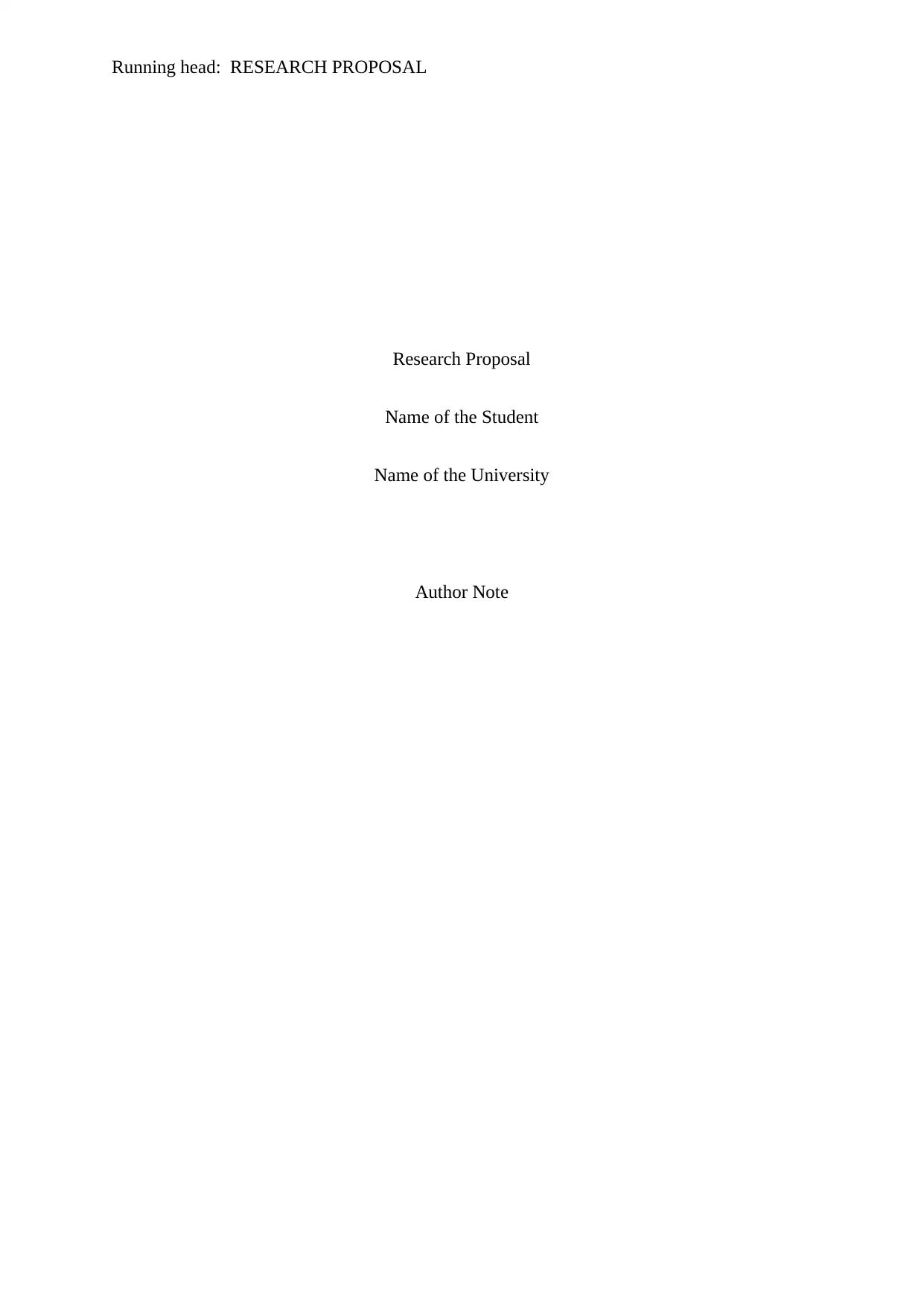
Running head: RESEARCH PROPOSAL
Research Proposal
Name of the Student
Name of the University
Author Note
Research Proposal
Name of the Student
Name of the University
Author Note
Paraphrase This Document
Need a fresh take? Get an instant paraphrase of this document with our AI Paraphraser
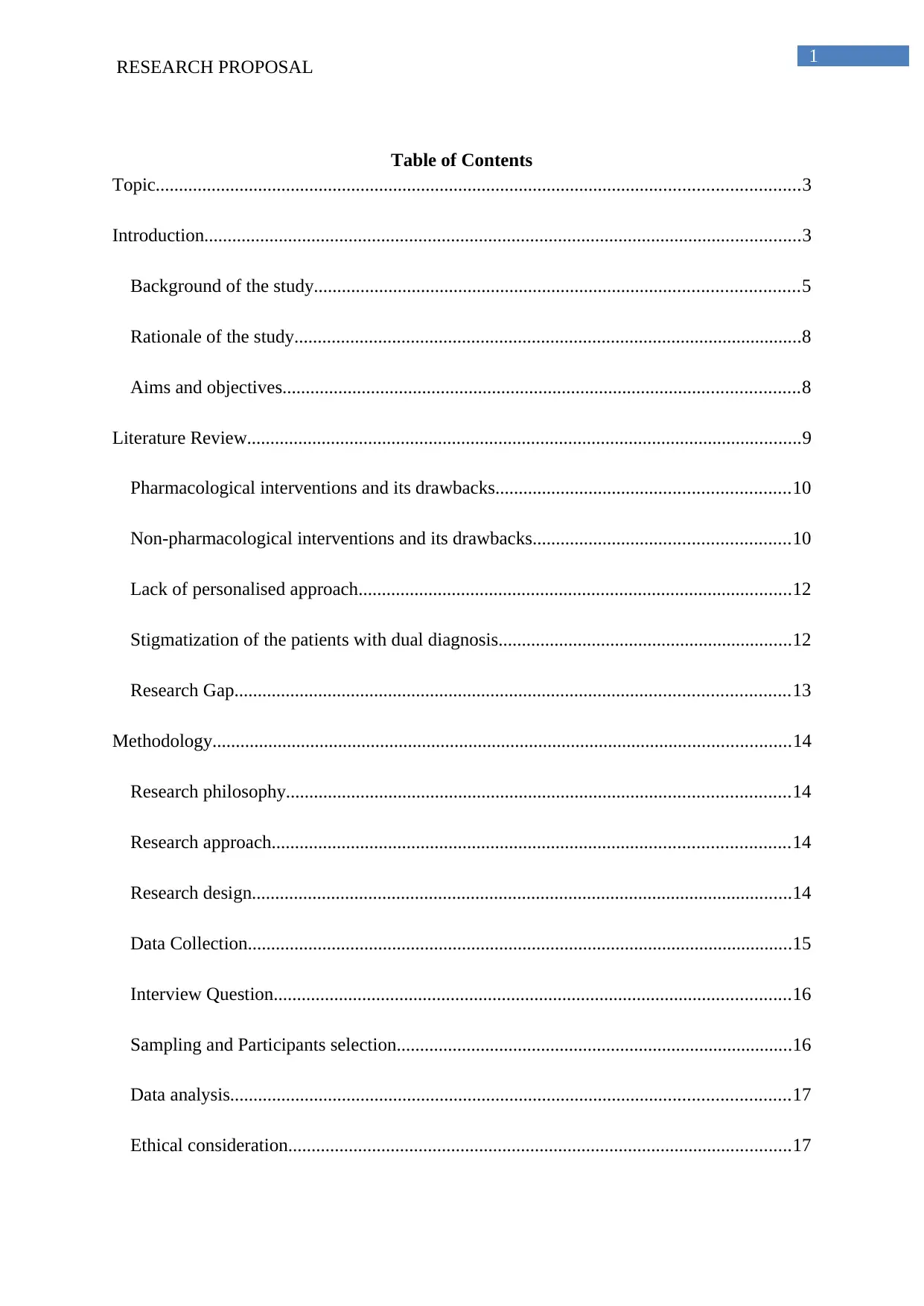
1
RESEARCH PROPOSAL
Table of Contents
Topic..........................................................................................................................................3
Introduction................................................................................................................................3
Background of the study........................................................................................................5
Rationale of the study.............................................................................................................8
Aims and objectives...............................................................................................................8
Literature Review.......................................................................................................................9
Pharmacological interventions and its drawbacks...............................................................10
Non-pharmacological interventions and its drawbacks.......................................................10
Lack of personalised approach.............................................................................................12
Stigmatization of the patients with dual diagnosis...............................................................12
Research Gap.......................................................................................................................13
Methodology............................................................................................................................14
Research philosophy............................................................................................................14
Research approach...............................................................................................................14
Research design....................................................................................................................14
Data Collection.....................................................................................................................15
Interview Question...............................................................................................................16
Sampling and Participants selection.....................................................................................16
Data analysis........................................................................................................................17
Ethical consideration............................................................................................................17
RESEARCH PROPOSAL
Table of Contents
Topic..........................................................................................................................................3
Introduction................................................................................................................................3
Background of the study........................................................................................................5
Rationale of the study.............................................................................................................8
Aims and objectives...............................................................................................................8
Literature Review.......................................................................................................................9
Pharmacological interventions and its drawbacks...............................................................10
Non-pharmacological interventions and its drawbacks.......................................................10
Lack of personalised approach.............................................................................................12
Stigmatization of the patients with dual diagnosis...............................................................12
Research Gap.......................................................................................................................13
Methodology............................................................................................................................14
Research philosophy............................................................................................................14
Research approach...............................................................................................................14
Research design....................................................................................................................14
Data Collection.....................................................................................................................15
Interview Question...............................................................................................................16
Sampling and Participants selection.....................................................................................16
Data analysis........................................................................................................................17
Ethical consideration............................................................................................................17

2
RESEARCH PROPOSAL
Conclusion................................................................................................................................19
Time Plan of the research.........................................................................................................19
Grant Chart...........................................................................................................................19
References................................................................................................................................21
RESEARCH PROPOSAL
Conclusion................................................................................................................................19
Time Plan of the research.........................................................................................................19
Grant Chart...........................................................................................................................19
References................................................................................................................................21
⊘ This is a preview!⊘
Do you want full access?
Subscribe today to unlock all pages.

Trusted by 1+ million students worldwide
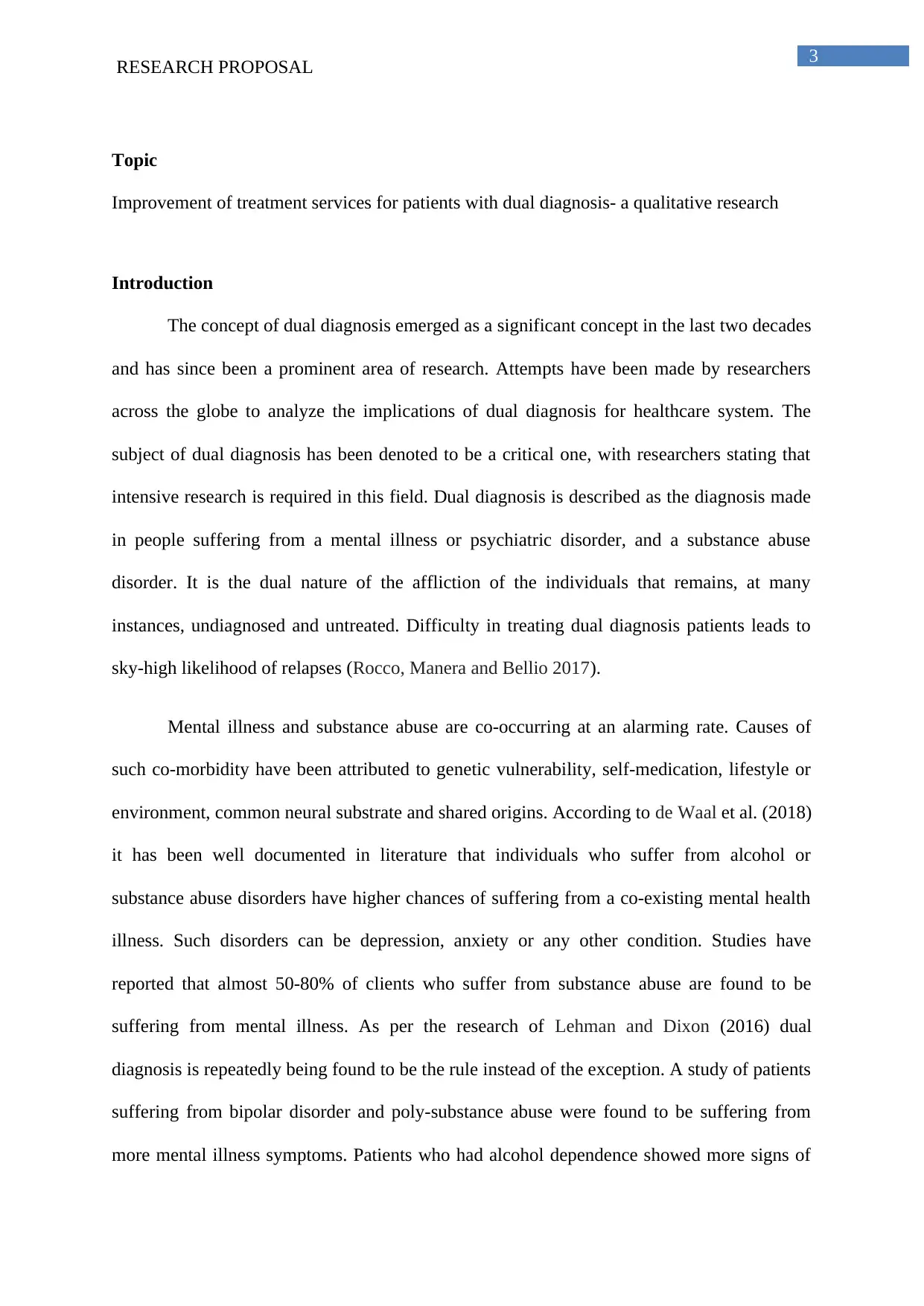
3
RESEARCH PROPOSAL
Topic
Improvement of treatment services for patients with dual diagnosis- a qualitative research
Introduction
The concept of dual diagnosis emerged as a significant concept in the last two decades
and has since been a prominent area of research. Attempts have been made by researchers
across the globe to analyze the implications of dual diagnosis for healthcare system. The
subject of dual diagnosis has been denoted to be a critical one, with researchers stating that
intensive research is required in this field. Dual diagnosis is described as the diagnosis made
in people suffering from a mental illness or psychiatric disorder, and a substance abuse
disorder. It is the dual nature of the affliction of the individuals that remains, at many
instances, undiagnosed and untreated. Difficulty in treating dual diagnosis patients leads to
sky-high likelihood of relapses (Rocco, Manera and Bellio 2017).
Mental illness and substance abuse are co-occurring at an alarming rate. Causes of
such co-morbidity have been attributed to genetic vulnerability, self-medication, lifestyle or
environment, common neural substrate and shared origins. According to de Waal et al. (2018)
it has been well documented in literature that individuals who suffer from alcohol or
substance abuse disorders have higher chances of suffering from a co-existing mental health
illness. Such disorders can be depression, anxiety or any other condition. Studies have
reported that almost 50-80% of clients who suffer from substance abuse are found to be
suffering from mental illness. As per the research of Lehman and Dixon (2016) dual
diagnosis is repeatedly being found to be the rule instead of the exception. A study of patients
suffering from bipolar disorder and poly-substance abuse were found to be suffering from
more mental illness symptoms. Patients who had alcohol dependence showed more signs of
RESEARCH PROPOSAL
Topic
Improvement of treatment services for patients with dual diagnosis- a qualitative research
Introduction
The concept of dual diagnosis emerged as a significant concept in the last two decades
and has since been a prominent area of research. Attempts have been made by researchers
across the globe to analyze the implications of dual diagnosis for healthcare system. The
subject of dual diagnosis has been denoted to be a critical one, with researchers stating that
intensive research is required in this field. Dual diagnosis is described as the diagnosis made
in people suffering from a mental illness or psychiatric disorder, and a substance abuse
disorder. It is the dual nature of the affliction of the individuals that remains, at many
instances, undiagnosed and untreated. Difficulty in treating dual diagnosis patients leads to
sky-high likelihood of relapses (Rocco, Manera and Bellio 2017).
Mental illness and substance abuse are co-occurring at an alarming rate. Causes of
such co-morbidity have been attributed to genetic vulnerability, self-medication, lifestyle or
environment, common neural substrate and shared origins. According to de Waal et al. (2018)
it has been well documented in literature that individuals who suffer from alcohol or
substance abuse disorders have higher chances of suffering from a co-existing mental health
illness. Such disorders can be depression, anxiety or any other condition. Studies have
reported that almost 50-80% of clients who suffer from substance abuse are found to be
suffering from mental illness. As per the research of Lehman and Dixon (2016) dual
diagnosis is repeatedly being found to be the rule instead of the exception. A study of patients
suffering from bipolar disorder and poly-substance abuse were found to be suffering from
more mental illness symptoms. Patients who had alcohol dependence showed more signs of
Paraphrase This Document
Need a fresh take? Get an instant paraphrase of this document with our AI Paraphraser
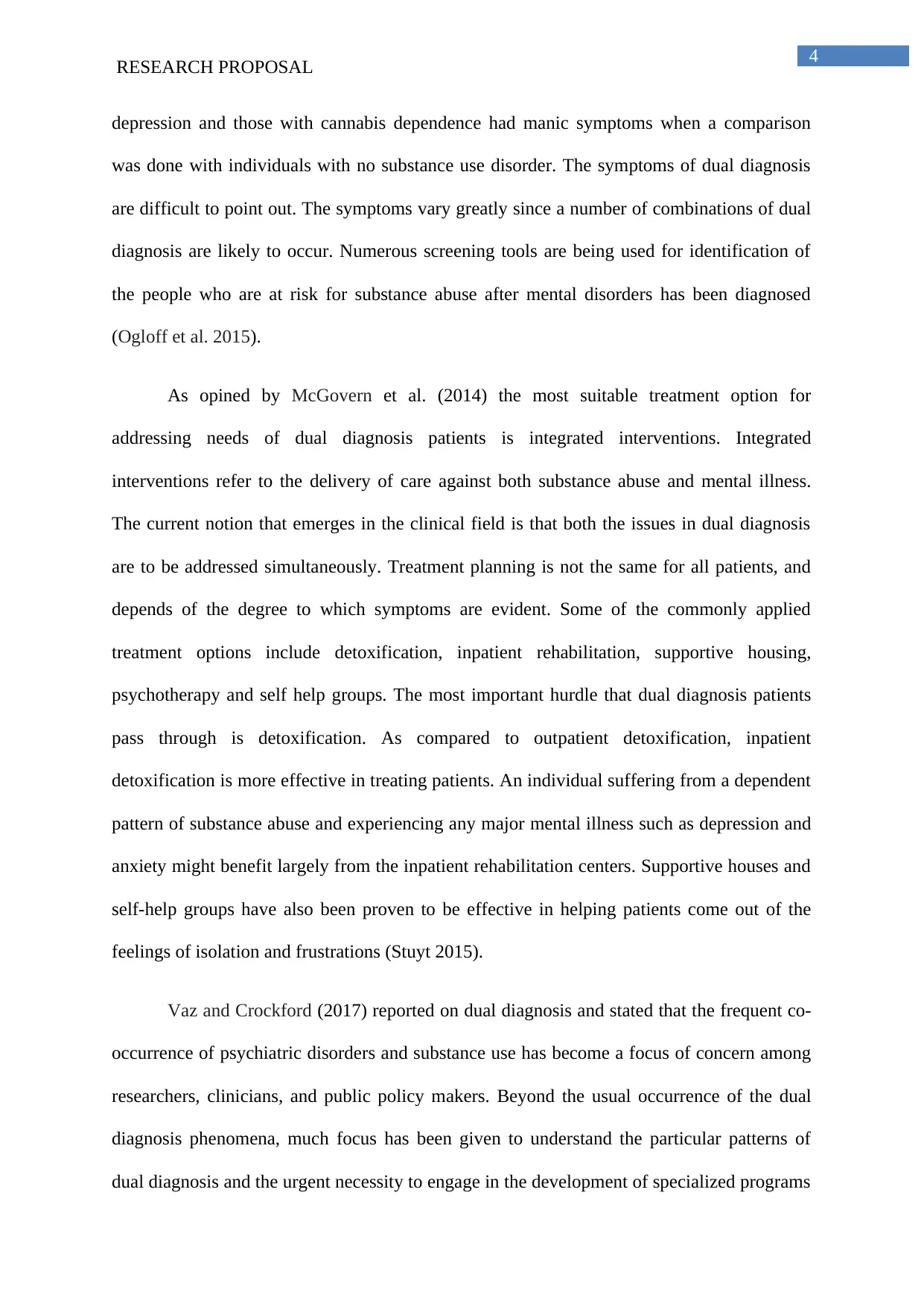
4
RESEARCH PROPOSAL
depression and those with cannabis dependence had manic symptoms when a comparison
was done with individuals with no substance use disorder. The symptoms of dual diagnosis
are difficult to point out. The symptoms vary greatly since a number of combinations of dual
diagnosis are likely to occur. Numerous screening tools are being used for identification of
the people who are at risk for substance abuse after mental disorders has been diagnosed
(Ogloff et al. 2015).
As opined by McGovern et al. (2014) the most suitable treatment option for
addressing needs of dual diagnosis patients is integrated interventions. Integrated
interventions refer to the delivery of care against both substance abuse and mental illness.
The current notion that emerges in the clinical field is that both the issues in dual diagnosis
are to be addressed simultaneously. Treatment planning is not the same for all patients, and
depends of the degree to which symptoms are evident. Some of the commonly applied
treatment options include detoxification, inpatient rehabilitation, supportive housing,
psychotherapy and self help groups. The most important hurdle that dual diagnosis patients
pass through is detoxification. As compared to outpatient detoxification, inpatient
detoxification is more effective in treating patients. An individual suffering from a dependent
pattern of substance abuse and experiencing any major mental illness such as depression and
anxiety might benefit largely from the inpatient rehabilitation centers. Supportive houses and
self-help groups have also been proven to be effective in helping patients come out of the
feelings of isolation and frustrations (Stuyt 2015).
Vaz and Crockford (2017) reported on dual diagnosis and stated that the frequent co-
occurrence of psychiatric disorders and substance use has become a focus of concern among
researchers, clinicians, and public policy makers. Beyond the usual occurrence of the dual
diagnosis phenomena, much focus has been given to understand the particular patterns of
dual diagnosis and the urgent necessity to engage in the development of specialized programs
RESEARCH PROPOSAL
depression and those with cannabis dependence had manic symptoms when a comparison
was done with individuals with no substance use disorder. The symptoms of dual diagnosis
are difficult to point out. The symptoms vary greatly since a number of combinations of dual
diagnosis are likely to occur. Numerous screening tools are being used for identification of
the people who are at risk for substance abuse after mental disorders has been diagnosed
(Ogloff et al. 2015).
As opined by McGovern et al. (2014) the most suitable treatment option for
addressing needs of dual diagnosis patients is integrated interventions. Integrated
interventions refer to the delivery of care against both substance abuse and mental illness.
The current notion that emerges in the clinical field is that both the issues in dual diagnosis
are to be addressed simultaneously. Treatment planning is not the same for all patients, and
depends of the degree to which symptoms are evident. Some of the commonly applied
treatment options include detoxification, inpatient rehabilitation, supportive housing,
psychotherapy and self help groups. The most important hurdle that dual diagnosis patients
pass through is detoxification. As compared to outpatient detoxification, inpatient
detoxification is more effective in treating patients. An individual suffering from a dependent
pattern of substance abuse and experiencing any major mental illness such as depression and
anxiety might benefit largely from the inpatient rehabilitation centers. Supportive houses and
self-help groups have also been proven to be effective in helping patients come out of the
feelings of isolation and frustrations (Stuyt 2015).
Vaz and Crockford (2017) reported on dual diagnosis and stated that the frequent co-
occurrence of psychiatric disorders and substance use has become a focus of concern among
researchers, clinicians, and public policy makers. Beyond the usual occurrence of the dual
diagnosis phenomena, much focus has been given to understand the particular patterns of
dual diagnosis and the urgent necessity to engage in the development of specialized programs
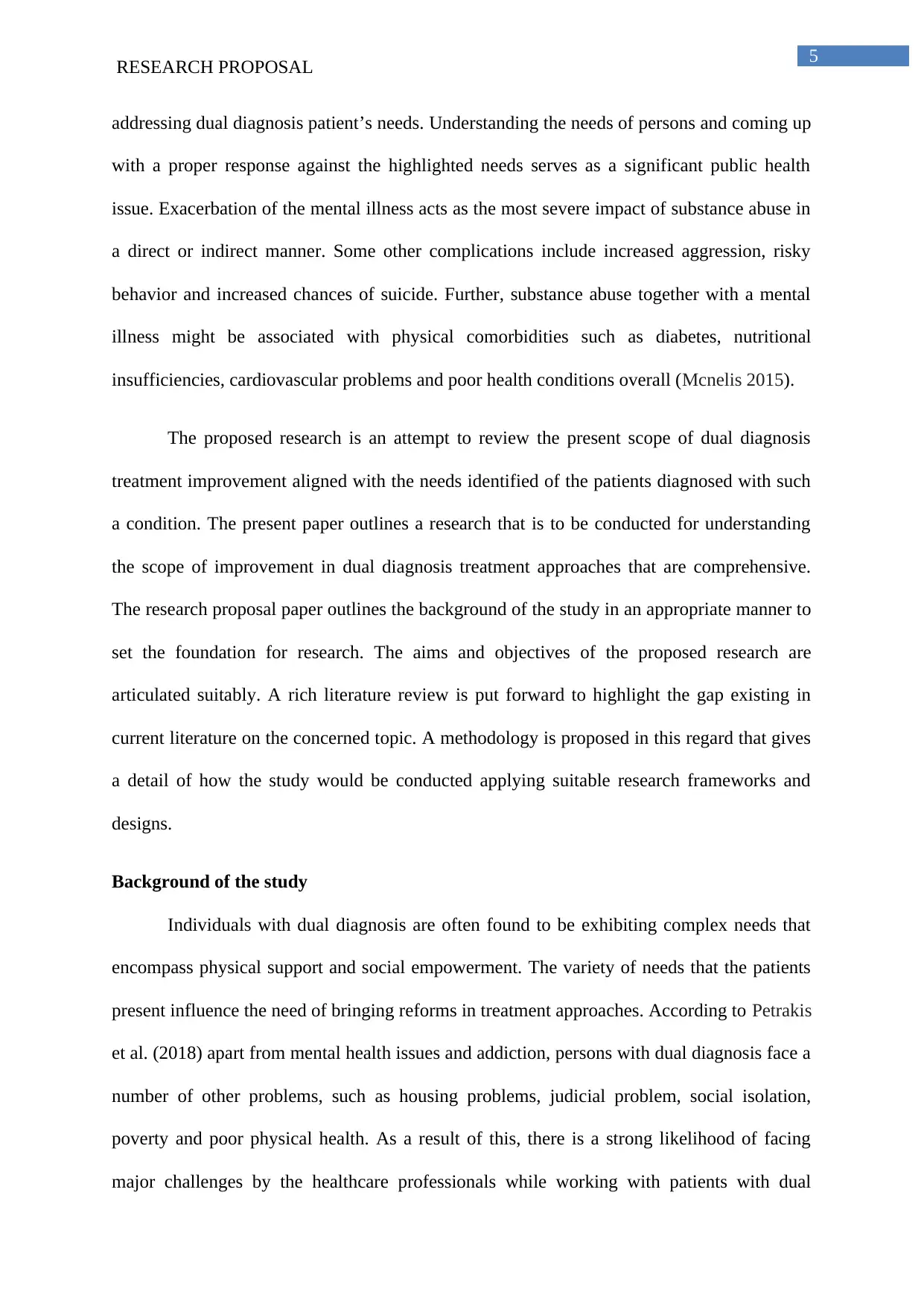
5
RESEARCH PROPOSAL
addressing dual diagnosis patient’s needs. Understanding the needs of persons and coming up
with a proper response against the highlighted needs serves as a significant public health
issue. Exacerbation of the mental illness acts as the most severe impact of substance abuse in
a direct or indirect manner. Some other complications include increased aggression, risky
behavior and increased chances of suicide. Further, substance abuse together with a mental
illness might be associated with physical comorbidities such as diabetes, nutritional
insufficiencies, cardiovascular problems and poor health conditions overall (Mcnelis 2015).
The proposed research is an attempt to review the present scope of dual diagnosis
treatment improvement aligned with the needs identified of the patients diagnosed with such
a condition. The present paper outlines a research that is to be conducted for understanding
the scope of improvement in dual diagnosis treatment approaches that are comprehensive.
The research proposal paper outlines the background of the study in an appropriate manner to
set the foundation for research. The aims and objectives of the proposed research are
articulated suitably. A rich literature review is put forward to highlight the gap existing in
current literature on the concerned topic. A methodology is proposed in this regard that gives
a detail of how the study would be conducted applying suitable research frameworks and
designs.
Background of the study
Individuals with dual diagnosis are often found to be exhibiting complex needs that
encompass physical support and social empowerment. The variety of needs that the patients
present influence the need of bringing reforms in treatment approaches. According to Petrakis
et al. (2018) apart from mental health issues and addiction, persons with dual diagnosis face a
number of other problems, such as housing problems, judicial problem, social isolation,
poverty and poor physical health. As a result of this, there is a strong likelihood of facing
major challenges by the healthcare professionals while working with patients with dual
RESEARCH PROPOSAL
addressing dual diagnosis patient’s needs. Understanding the needs of persons and coming up
with a proper response against the highlighted needs serves as a significant public health
issue. Exacerbation of the mental illness acts as the most severe impact of substance abuse in
a direct or indirect manner. Some other complications include increased aggression, risky
behavior and increased chances of suicide. Further, substance abuse together with a mental
illness might be associated with physical comorbidities such as diabetes, nutritional
insufficiencies, cardiovascular problems and poor health conditions overall (Mcnelis 2015).
The proposed research is an attempt to review the present scope of dual diagnosis
treatment improvement aligned with the needs identified of the patients diagnosed with such
a condition. The present paper outlines a research that is to be conducted for understanding
the scope of improvement in dual diagnosis treatment approaches that are comprehensive.
The research proposal paper outlines the background of the study in an appropriate manner to
set the foundation for research. The aims and objectives of the proposed research are
articulated suitably. A rich literature review is put forward to highlight the gap existing in
current literature on the concerned topic. A methodology is proposed in this regard that gives
a detail of how the study would be conducted applying suitable research frameworks and
designs.
Background of the study
Individuals with dual diagnosis are often found to be exhibiting complex needs that
encompass physical support and social empowerment. The variety of needs that the patients
present influence the need of bringing reforms in treatment approaches. According to Petrakis
et al. (2018) apart from mental health issues and addiction, persons with dual diagnosis face a
number of other problems, such as housing problems, judicial problem, social isolation,
poverty and poor physical health. As a result of this, there is a strong likelihood of facing
major challenges by the healthcare professionals while working with patients with dual
⊘ This is a preview!⊘
Do you want full access?
Subscribe today to unlock all pages.

Trusted by 1+ million students worldwide
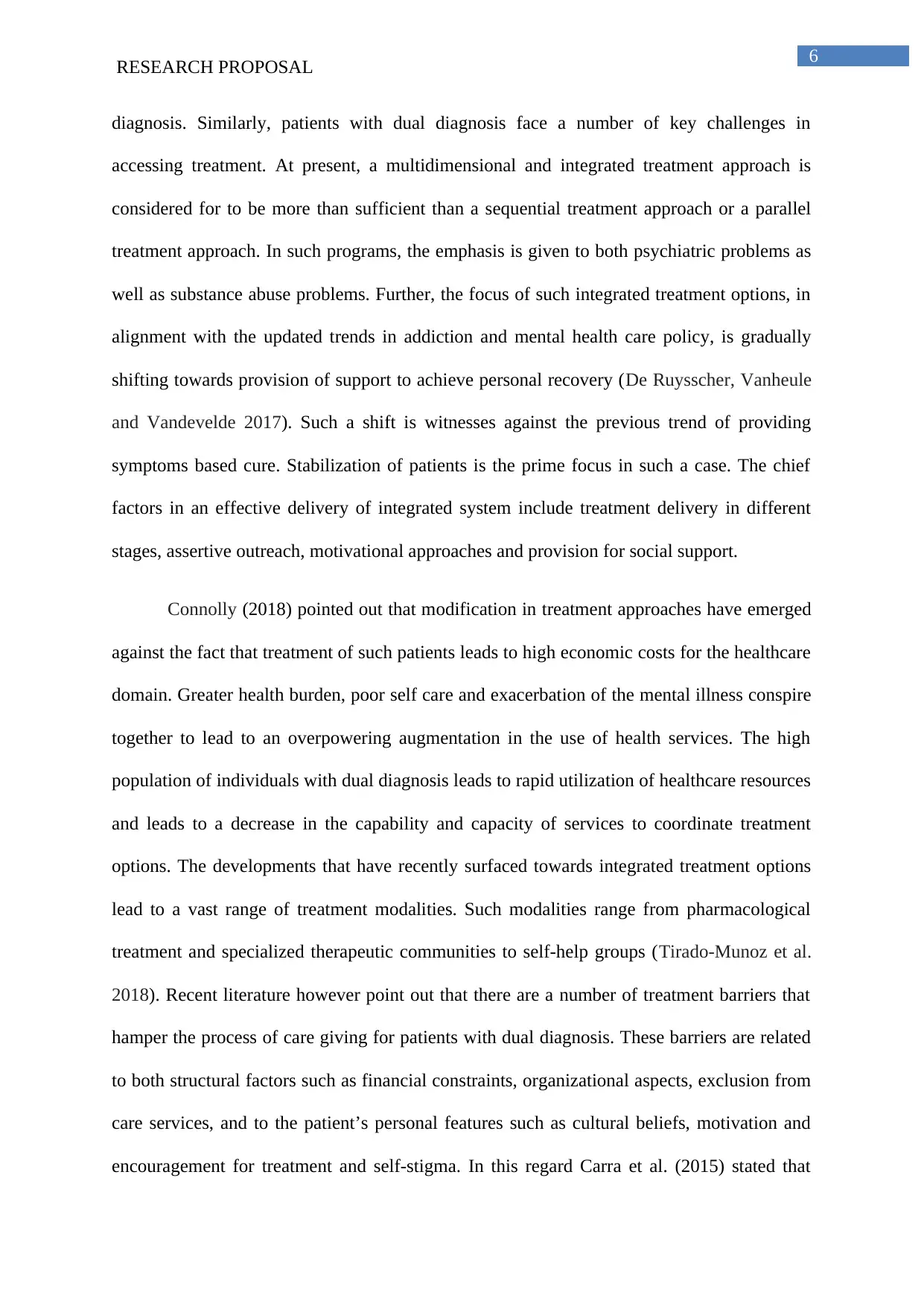
6
RESEARCH PROPOSAL
diagnosis. Similarly, patients with dual diagnosis face a number of key challenges in
accessing treatment. At present, a multidimensional and integrated treatment approach is
considered for to be more than sufficient than a sequential treatment approach or a parallel
treatment approach. In such programs, the emphasis is given to both psychiatric problems as
well as substance abuse problems. Further, the focus of such integrated treatment options, in
alignment with the updated trends in addiction and mental health care policy, is gradually
shifting towards provision of support to achieve personal recovery (De Ruysscher, Vanheule
and Vandevelde 2017). Such a shift is witnesses against the previous trend of providing
symptoms based cure. Stabilization of patients is the prime focus in such a case. The chief
factors in an effective delivery of integrated system include treatment delivery in different
stages, assertive outreach, motivational approaches and provision for social support.
Connolly (2018) pointed out that modification in treatment approaches have emerged
against the fact that treatment of such patients leads to high economic costs for the healthcare
domain. Greater health burden, poor self care and exacerbation of the mental illness conspire
together to lead to an overpowering augmentation in the use of health services. The high
population of individuals with dual diagnosis leads to rapid utilization of healthcare resources
and leads to a decrease in the capability and capacity of services to coordinate treatment
options. The developments that have recently surfaced towards integrated treatment options
lead to a vast range of treatment modalities. Such modalities range from pharmacological
treatment and specialized therapeutic communities to self-help groups (Tirado-Munoz et al.
2018). Recent literature however point out that there are a number of treatment barriers that
hamper the process of care giving for patients with dual diagnosis. These barriers are related
to both structural factors such as financial constraints, organizational aspects, exclusion from
care services, and to the patient’s personal features such as cultural beliefs, motivation and
encouragement for treatment and self-stigma. In this regard Carra et al. (2015) stated that
RESEARCH PROPOSAL
diagnosis. Similarly, patients with dual diagnosis face a number of key challenges in
accessing treatment. At present, a multidimensional and integrated treatment approach is
considered for to be more than sufficient than a sequential treatment approach or a parallel
treatment approach. In such programs, the emphasis is given to both psychiatric problems as
well as substance abuse problems. Further, the focus of such integrated treatment options, in
alignment with the updated trends in addiction and mental health care policy, is gradually
shifting towards provision of support to achieve personal recovery (De Ruysscher, Vanheule
and Vandevelde 2017). Such a shift is witnesses against the previous trend of providing
symptoms based cure. Stabilization of patients is the prime focus in such a case. The chief
factors in an effective delivery of integrated system include treatment delivery in different
stages, assertive outreach, motivational approaches and provision for social support.
Connolly (2018) pointed out that modification in treatment approaches have emerged
against the fact that treatment of such patients leads to high economic costs for the healthcare
domain. Greater health burden, poor self care and exacerbation of the mental illness conspire
together to lead to an overpowering augmentation in the use of health services. The high
population of individuals with dual diagnosis leads to rapid utilization of healthcare resources
and leads to a decrease in the capability and capacity of services to coordinate treatment
options. The developments that have recently surfaced towards integrated treatment options
lead to a vast range of treatment modalities. Such modalities range from pharmacological
treatment and specialized therapeutic communities to self-help groups (Tirado-Munoz et al.
2018). Recent literature however point out that there are a number of treatment barriers that
hamper the process of care giving for patients with dual diagnosis. These barriers are related
to both structural factors such as financial constraints, organizational aspects, exclusion from
care services, and to the patient’s personal features such as cultural beliefs, motivation and
encouragement for treatment and self-stigma. In this regard Carra et al. (2015) stated that
Paraphrase This Document
Need a fresh take? Get an instant paraphrase of this document with our AI Paraphraser
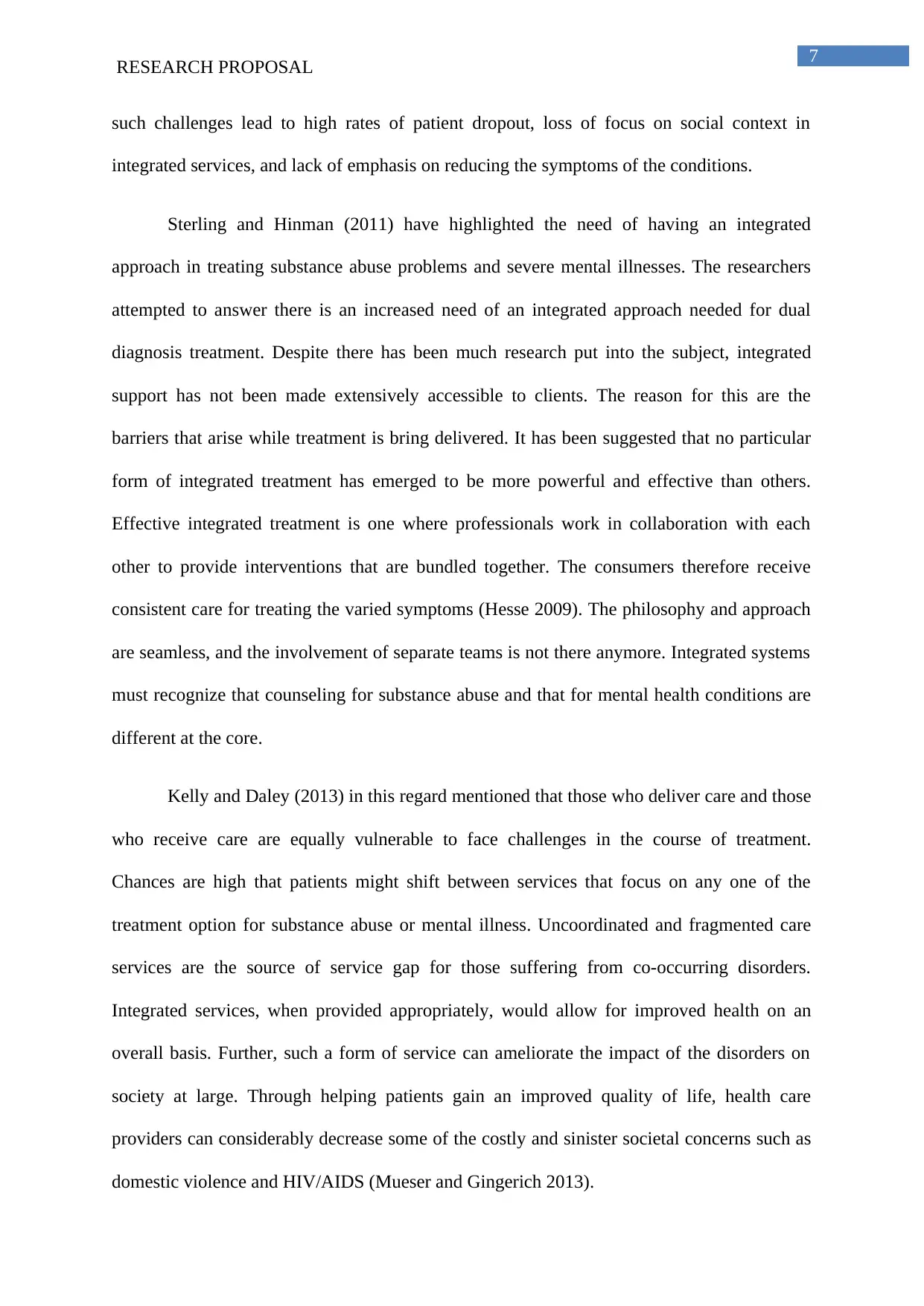
7
RESEARCH PROPOSAL
such challenges lead to high rates of patient dropout, loss of focus on social context in
integrated services, and lack of emphasis on reducing the symptoms of the conditions.
Sterling and Hinman (2011) have highlighted the need of having an integrated
approach in treating substance abuse problems and severe mental illnesses. The researchers
attempted to answer there is an increased need of an integrated approach needed for dual
diagnosis treatment. Despite there has been much research put into the subject, integrated
support has not been made extensively accessible to clients. The reason for this are the
barriers that arise while treatment is bring delivered. It has been suggested that no particular
form of integrated treatment has emerged to be more powerful and effective than others.
Effective integrated treatment is one where professionals work in collaboration with each
other to provide interventions that are bundled together. The consumers therefore receive
consistent care for treating the varied symptoms (Hesse 2009). The philosophy and approach
are seamless, and the involvement of separate teams is not there anymore. Integrated systems
must recognize that counseling for substance abuse and that for mental health conditions are
different at the core.
Kelly and Daley (2013) in this regard mentioned that those who deliver care and those
who receive care are equally vulnerable to face challenges in the course of treatment.
Chances are high that patients might shift between services that focus on any one of the
treatment option for substance abuse or mental illness. Uncoordinated and fragmented care
services are the source of service gap for those suffering from co-occurring disorders.
Integrated services, when provided appropriately, would allow for improved health on an
overall basis. Further, such a form of service can ameliorate the impact of the disorders on
society at large. Through helping patients gain an improved quality of life, health care
providers can considerably decrease some of the costly and sinister societal concerns such as
domestic violence and HIV/AIDS (Mueser and Gingerich 2013).
RESEARCH PROPOSAL
such challenges lead to high rates of patient dropout, loss of focus on social context in
integrated services, and lack of emphasis on reducing the symptoms of the conditions.
Sterling and Hinman (2011) have highlighted the need of having an integrated
approach in treating substance abuse problems and severe mental illnesses. The researchers
attempted to answer there is an increased need of an integrated approach needed for dual
diagnosis treatment. Despite there has been much research put into the subject, integrated
support has not been made extensively accessible to clients. The reason for this are the
barriers that arise while treatment is bring delivered. It has been suggested that no particular
form of integrated treatment has emerged to be more powerful and effective than others.
Effective integrated treatment is one where professionals work in collaboration with each
other to provide interventions that are bundled together. The consumers therefore receive
consistent care for treating the varied symptoms (Hesse 2009). The philosophy and approach
are seamless, and the involvement of separate teams is not there anymore. Integrated systems
must recognize that counseling for substance abuse and that for mental health conditions are
different at the core.
Kelly and Daley (2013) in this regard mentioned that those who deliver care and those
who receive care are equally vulnerable to face challenges in the course of treatment.
Chances are high that patients might shift between services that focus on any one of the
treatment option for substance abuse or mental illness. Uncoordinated and fragmented care
services are the source of service gap for those suffering from co-occurring disorders.
Integrated services, when provided appropriately, would allow for improved health on an
overall basis. Further, such a form of service can ameliorate the impact of the disorders on
society at large. Through helping patients gain an improved quality of life, health care
providers can considerably decrease some of the costly and sinister societal concerns such as
domestic violence and HIV/AIDS (Mueser and Gingerich 2013).
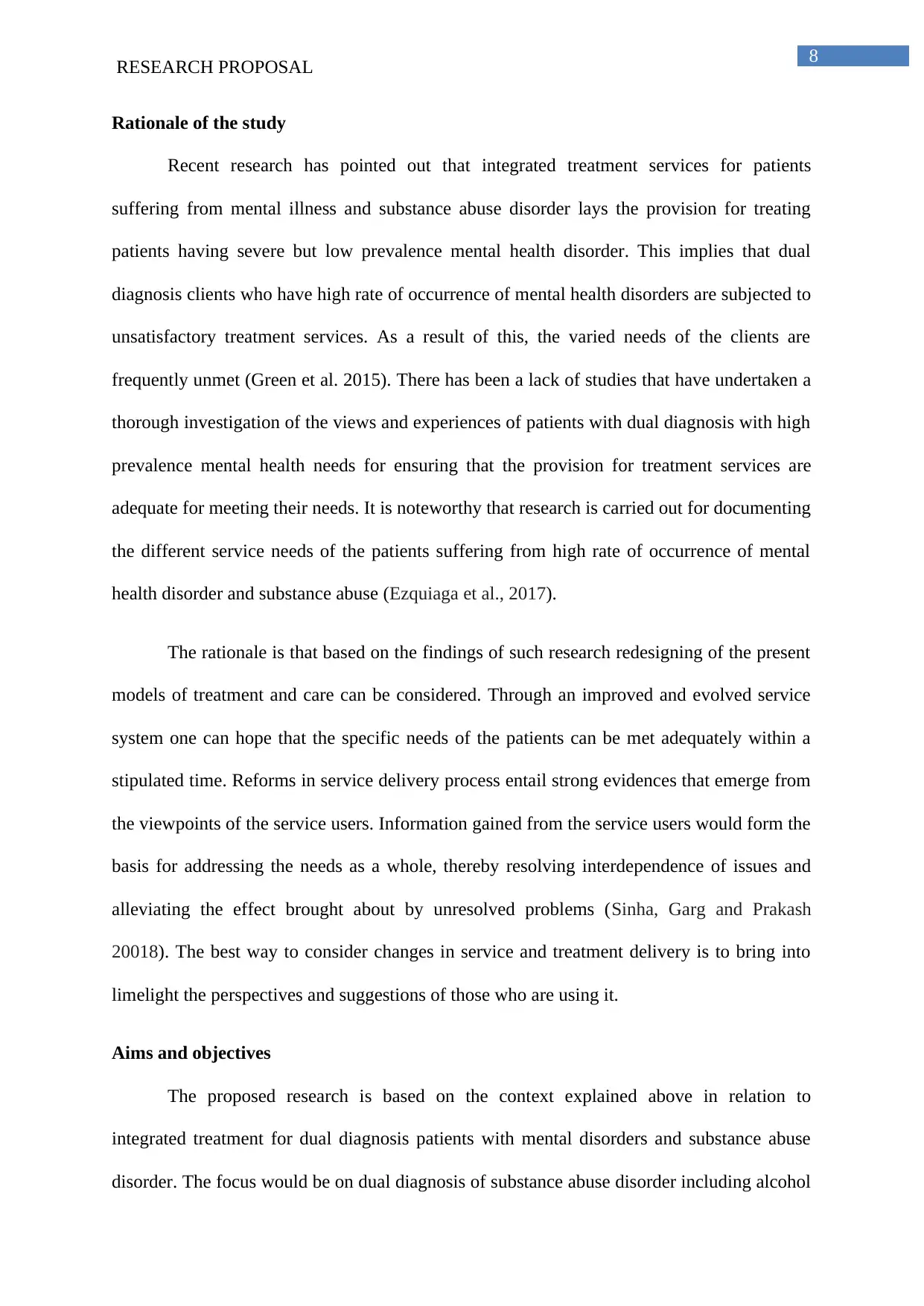
8
RESEARCH PROPOSAL
Rationale of the study
Recent research has pointed out that integrated treatment services for patients
suffering from mental illness and substance abuse disorder lays the provision for treating
patients having severe but low prevalence mental health disorder. This implies that dual
diagnosis clients who have high rate of occurrence of mental health disorders are subjected to
unsatisfactory treatment services. As a result of this, the varied needs of the clients are
frequently unmet (Green et al. 2015). There has been a lack of studies that have undertaken a
thorough investigation of the views and experiences of patients with dual diagnosis with high
prevalence mental health needs for ensuring that the provision for treatment services are
adequate for meeting their needs. It is noteworthy that research is carried out for documenting
the different service needs of the patients suffering from high rate of occurrence of mental
health disorder and substance abuse (Ezquiaga et al., 2017).
The rationale is that based on the findings of such research redesigning of the present
models of treatment and care can be considered. Through an improved and evolved service
system one can hope that the specific needs of the patients can be met adequately within a
stipulated time. Reforms in service delivery process entail strong evidences that emerge from
the viewpoints of the service users. Information gained from the service users would form the
basis for addressing the needs as a whole, thereby resolving interdependence of issues and
alleviating the effect brought about by unresolved problems (Sinha, Garg and Prakash
20018). The best way to consider changes in service and treatment delivery is to bring into
limelight the perspectives and suggestions of those who are using it.
Aims and objectives
The proposed research is based on the context explained above in relation to
integrated treatment for dual diagnosis patients with mental disorders and substance abuse
disorder. The focus would be on dual diagnosis of substance abuse disorder including alcohol
RESEARCH PROPOSAL
Rationale of the study
Recent research has pointed out that integrated treatment services for patients
suffering from mental illness and substance abuse disorder lays the provision for treating
patients having severe but low prevalence mental health disorder. This implies that dual
diagnosis clients who have high rate of occurrence of mental health disorders are subjected to
unsatisfactory treatment services. As a result of this, the varied needs of the clients are
frequently unmet (Green et al. 2015). There has been a lack of studies that have undertaken a
thorough investigation of the views and experiences of patients with dual diagnosis with high
prevalence mental health needs for ensuring that the provision for treatment services are
adequate for meeting their needs. It is noteworthy that research is carried out for documenting
the different service needs of the patients suffering from high rate of occurrence of mental
health disorder and substance abuse (Ezquiaga et al., 2017).
The rationale is that based on the findings of such research redesigning of the present
models of treatment and care can be considered. Through an improved and evolved service
system one can hope that the specific needs of the patients can be met adequately within a
stipulated time. Reforms in service delivery process entail strong evidences that emerge from
the viewpoints of the service users. Information gained from the service users would form the
basis for addressing the needs as a whole, thereby resolving interdependence of issues and
alleviating the effect brought about by unresolved problems (Sinha, Garg and Prakash
20018). The best way to consider changes in service and treatment delivery is to bring into
limelight the perspectives and suggestions of those who are using it.
Aims and objectives
The proposed research is based on the context explained above in relation to
integrated treatment for dual diagnosis patients with mental disorders and substance abuse
disorder. The focus would be on dual diagnosis of substance abuse disorder including alcohol
⊘ This is a preview!⊘
Do you want full access?
Subscribe today to unlock all pages.

Trusted by 1+ million students worldwide
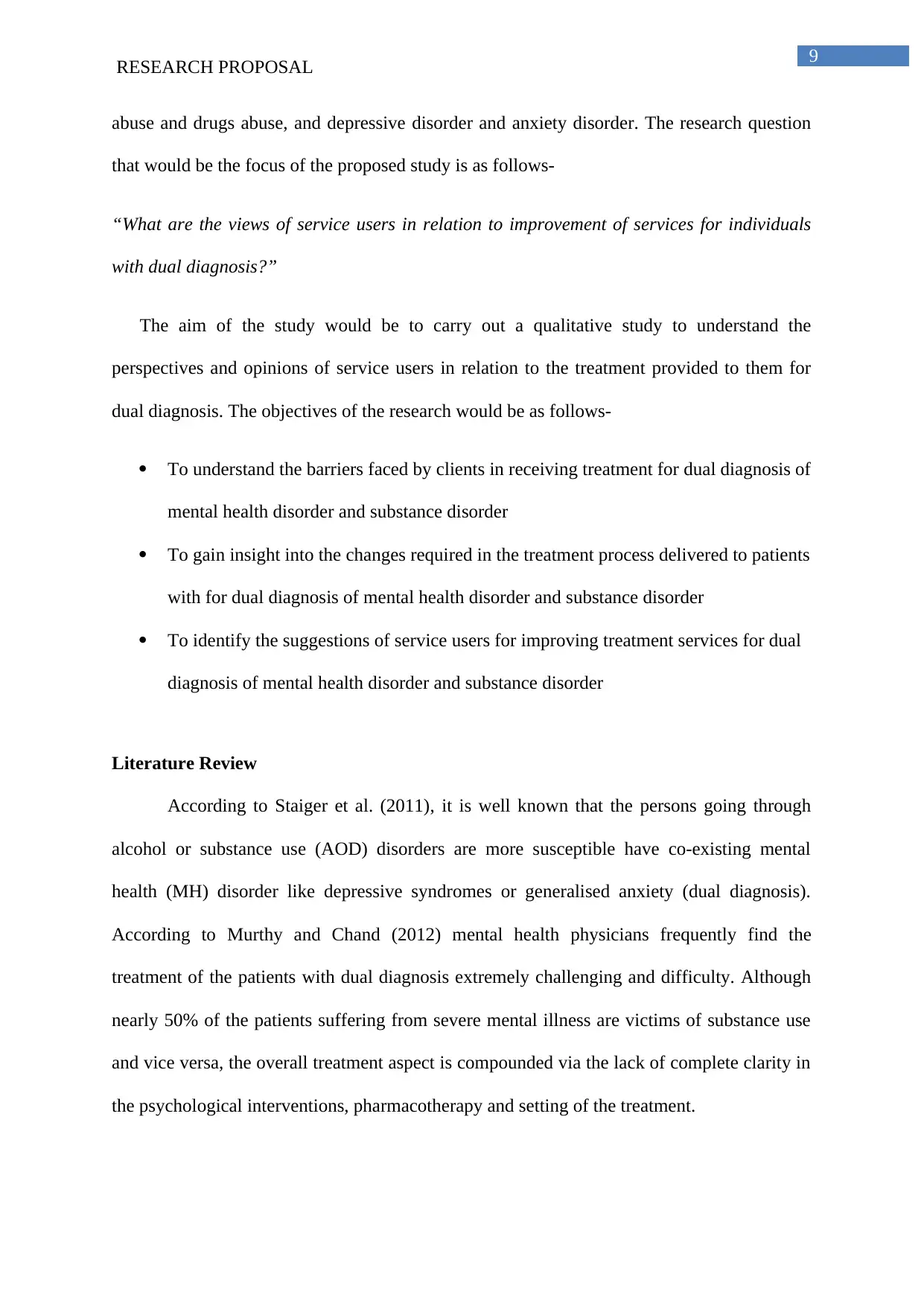
9
RESEARCH PROPOSAL
abuse and drugs abuse, and depressive disorder and anxiety disorder. The research question
that would be the focus of the proposed study is as follows-
“What are the views of service users in relation to improvement of services for individuals
with dual diagnosis?”
The aim of the study would be to carry out a qualitative study to understand the
perspectives and opinions of service users in relation to the treatment provided to them for
dual diagnosis. The objectives of the research would be as follows-
To understand the barriers faced by clients in receiving treatment for dual diagnosis of
mental health disorder and substance disorder
To gain insight into the changes required in the treatment process delivered to patients
with for dual diagnosis of mental health disorder and substance disorder
To identify the suggestions of service users for improving treatment services for dual
diagnosis of mental health disorder and substance disorder
Literature Review
According to Staiger et al. (2011), it is well known that the persons going through
alcohol or substance use (AOD) disorders are more susceptible have co-existing mental
health (MH) disorder like depressive syndromes or generalised anxiety (dual diagnosis).
According to Murthy and Chand (2012) mental health physicians frequently find the
treatment of the patients with dual diagnosis extremely challenging and difficulty. Although
nearly 50% of the patients suffering from severe mental illness are victims of substance use
and vice versa, the overall treatment aspect is compounded via the lack of complete clarity in
the psychological interventions, pharmacotherapy and setting of the treatment.
RESEARCH PROPOSAL
abuse and drugs abuse, and depressive disorder and anxiety disorder. The research question
that would be the focus of the proposed study is as follows-
“What are the views of service users in relation to improvement of services for individuals
with dual diagnosis?”
The aim of the study would be to carry out a qualitative study to understand the
perspectives and opinions of service users in relation to the treatment provided to them for
dual diagnosis. The objectives of the research would be as follows-
To understand the barriers faced by clients in receiving treatment for dual diagnosis of
mental health disorder and substance disorder
To gain insight into the changes required in the treatment process delivered to patients
with for dual diagnosis of mental health disorder and substance disorder
To identify the suggestions of service users for improving treatment services for dual
diagnosis of mental health disorder and substance disorder
Literature Review
According to Staiger et al. (2011), it is well known that the persons going through
alcohol or substance use (AOD) disorders are more susceptible have co-existing mental
health (MH) disorder like depressive syndromes or generalised anxiety (dual diagnosis).
According to Murthy and Chand (2012) mental health physicians frequently find the
treatment of the patients with dual diagnosis extremely challenging and difficulty. Although
nearly 50% of the patients suffering from severe mental illness are victims of substance use
and vice versa, the overall treatment aspect is compounded via the lack of complete clarity in
the psychological interventions, pharmacotherapy and setting of the treatment.
Paraphrase This Document
Need a fresh take? Get an instant paraphrase of this document with our AI Paraphraser
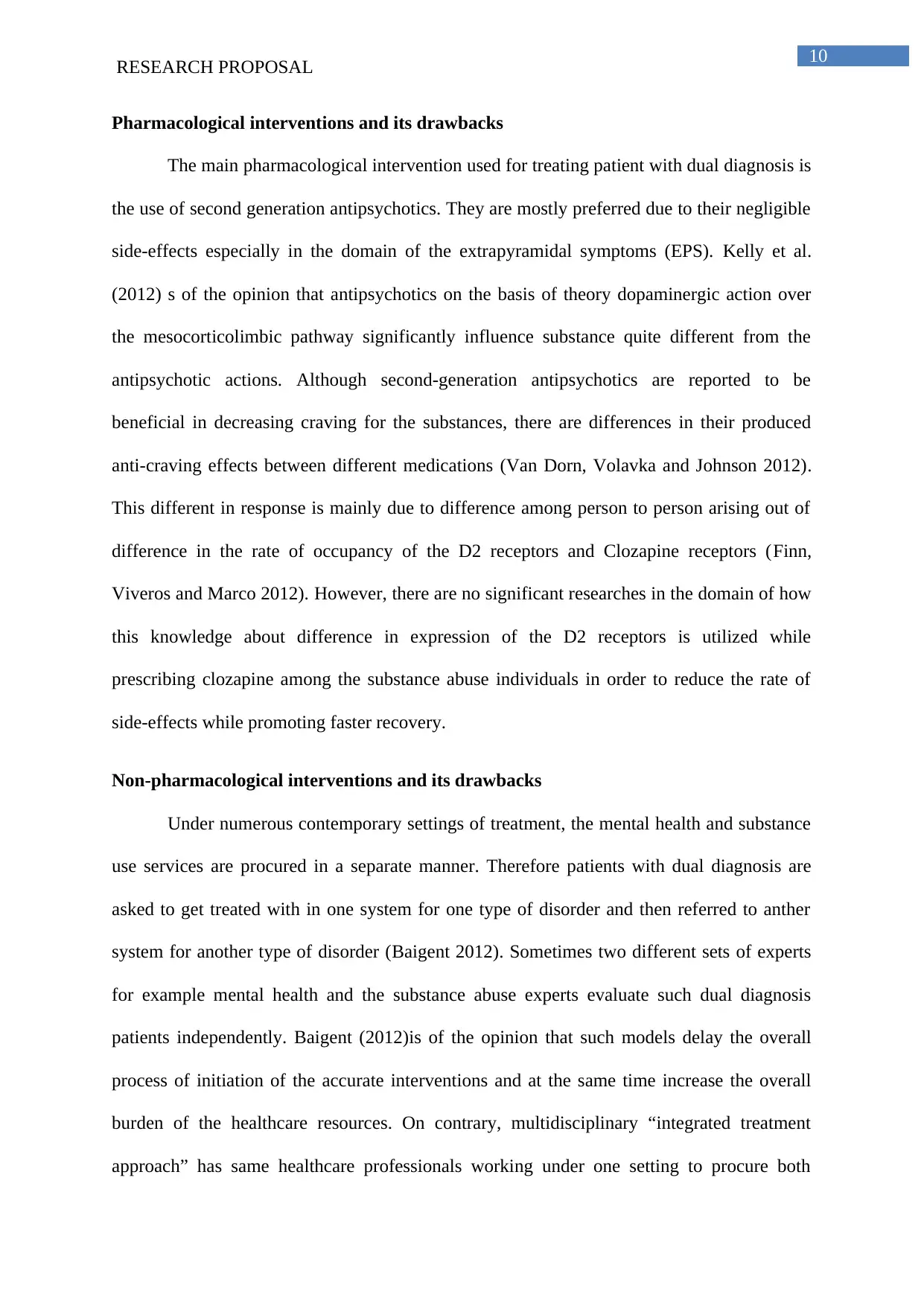
10
RESEARCH PROPOSAL
Pharmacological interventions and its drawbacks
The main pharmacological intervention used for treating patient with dual diagnosis is
the use of second generation antipsychotics. They are mostly preferred due to their negligible
side-effects especially in the domain of the extrapyramidal symptoms (EPS). Kelly et al.
(2012) s of the opinion that antipsychotics on the basis of theory dopaminergic action over
the mesocorticolimbic pathway significantly influence substance quite different from the
antipsychotic actions. Although second-generation antipsychotics are reported to be
beneficial in decreasing craving for the substances, there are differences in their produced
anti-craving effects between different medications (Van Dorn, Volavka and Johnson 2012).
This different in response is mainly due to difference among person to person arising out of
difference in the rate of occupancy of the D2 receptors and Clozapine receptors (Finn,
Viveros and Marco 2012). However, there are no significant researches in the domain of how
this knowledge about difference in expression of the D2 receptors is utilized while
prescribing clozapine among the substance abuse individuals in order to reduce the rate of
side-effects while promoting faster recovery.
Non-pharmacological interventions and its drawbacks
Under numerous contemporary settings of treatment, the mental health and substance
use services are procured in a separate manner. Therefore patients with dual diagnosis are
asked to get treated with in one system for one type of disorder and then referred to anther
system for another type of disorder (Baigent 2012). Sometimes two different sets of experts
for example mental health and the substance abuse experts evaluate such dual diagnosis
patients independently. Baigent (2012)is of the opinion that such models delay the overall
process of initiation of the accurate interventions and at the same time increase the overall
burden of the healthcare resources. On contrary, multidisciplinary “integrated treatment
approach” has same healthcare professionals working under one setting to procure both
RESEARCH PROPOSAL
Pharmacological interventions and its drawbacks
The main pharmacological intervention used for treating patient with dual diagnosis is
the use of second generation antipsychotics. They are mostly preferred due to their negligible
side-effects especially in the domain of the extrapyramidal symptoms (EPS). Kelly et al.
(2012) s of the opinion that antipsychotics on the basis of theory dopaminergic action over
the mesocorticolimbic pathway significantly influence substance quite different from the
antipsychotic actions. Although second-generation antipsychotics are reported to be
beneficial in decreasing craving for the substances, there are differences in their produced
anti-craving effects between different medications (Van Dorn, Volavka and Johnson 2012).
This different in response is mainly due to difference among person to person arising out of
difference in the rate of occupancy of the D2 receptors and Clozapine receptors (Finn,
Viveros and Marco 2012). However, there are no significant researches in the domain of how
this knowledge about difference in expression of the D2 receptors is utilized while
prescribing clozapine among the substance abuse individuals in order to reduce the rate of
side-effects while promoting faster recovery.
Non-pharmacological interventions and its drawbacks
Under numerous contemporary settings of treatment, the mental health and substance
use services are procured in a separate manner. Therefore patients with dual diagnosis are
asked to get treated with in one system for one type of disorder and then referred to anther
system for another type of disorder (Baigent 2012). Sometimes two different sets of experts
for example mental health and the substance abuse experts evaluate such dual diagnosis
patients independently. Baigent (2012)is of the opinion that such models delay the overall
process of initiation of the accurate interventions and at the same time increase the overall
burden of the healthcare resources. On contrary, multidisciplinary “integrated treatment
approach” has same healthcare professionals working under one setting to procure both
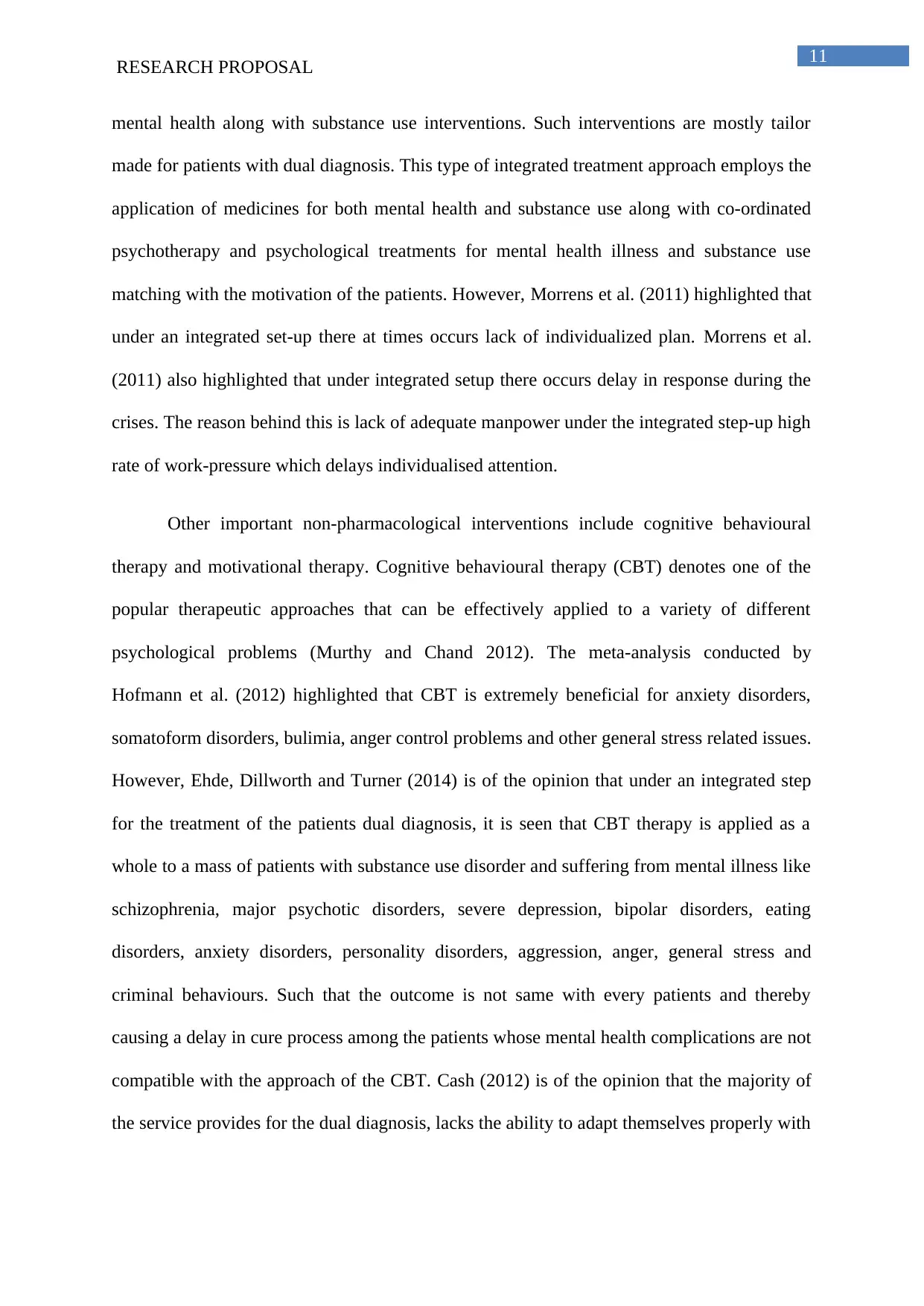
11
RESEARCH PROPOSAL
mental health along with substance use interventions. Such interventions are mostly tailor
made for patients with dual diagnosis. This type of integrated treatment approach employs the
application of medicines for both mental health and substance use along with co-ordinated
psychotherapy and psychological treatments for mental health illness and substance use
matching with the motivation of the patients. However, Morrens et al. (2011) highlighted that
under an integrated set-up there at times occurs lack of individualized plan. Morrens et al.
(2011) also highlighted that under integrated setup there occurs delay in response during the
crises. The reason behind this is lack of adequate manpower under the integrated step-up high
rate of work-pressure which delays individualised attention.
Other important non-pharmacological interventions include cognitive behavioural
therapy and motivational therapy. Cognitive behavioural therapy (CBT) denotes one of the
popular therapeutic approaches that can be effectively applied to a variety of different
psychological problems (Murthy and Chand 2012). The meta-analysis conducted by
Hofmann et al. (2012) highlighted that CBT is extremely beneficial for anxiety disorders,
somatoform disorders, bulimia, anger control problems and other general stress related issues.
However, Ehde, Dillworth and Turner (2014) is of the opinion that under an integrated step
for the treatment of the patients dual diagnosis, it is seen that CBT therapy is applied as a
whole to a mass of patients with substance use disorder and suffering from mental illness like
schizophrenia, major psychotic disorders, severe depression, bipolar disorders, eating
disorders, anxiety disorders, personality disorders, aggression, anger, general stress and
criminal behaviours. Such that the outcome is not same with every patients and thereby
causing a delay in cure process among the patients whose mental health complications are not
compatible with the approach of the CBT. Cash (2012) is of the opinion that the majority of
the service provides for the dual diagnosis, lacks the ability to adapt themselves properly with
RESEARCH PROPOSAL
mental health along with substance use interventions. Such interventions are mostly tailor
made for patients with dual diagnosis. This type of integrated treatment approach employs the
application of medicines for both mental health and substance use along with co-ordinated
psychotherapy and psychological treatments for mental health illness and substance use
matching with the motivation of the patients. However, Morrens et al. (2011) highlighted that
under an integrated set-up there at times occurs lack of individualized plan. Morrens et al.
(2011) also highlighted that under integrated setup there occurs delay in response during the
crises. The reason behind this is lack of adequate manpower under the integrated step-up high
rate of work-pressure which delays individualised attention.
Other important non-pharmacological interventions include cognitive behavioural
therapy and motivational therapy. Cognitive behavioural therapy (CBT) denotes one of the
popular therapeutic approaches that can be effectively applied to a variety of different
psychological problems (Murthy and Chand 2012). The meta-analysis conducted by
Hofmann et al. (2012) highlighted that CBT is extremely beneficial for anxiety disorders,
somatoform disorders, bulimia, anger control problems and other general stress related issues.
However, Ehde, Dillworth and Turner (2014) is of the opinion that under an integrated step
for the treatment of the patients dual diagnosis, it is seen that CBT therapy is applied as a
whole to a mass of patients with substance use disorder and suffering from mental illness like
schizophrenia, major psychotic disorders, severe depression, bipolar disorders, eating
disorders, anxiety disorders, personality disorders, aggression, anger, general stress and
criminal behaviours. Such that the outcome is not same with every patients and thereby
causing a delay in cure process among the patients whose mental health complications are not
compatible with the approach of the CBT. Cash (2012) is of the opinion that the majority of
the service provides for the dual diagnosis, lacks the ability to adapt themselves properly with
⊘ This is a preview!⊘
Do you want full access?
Subscribe today to unlock all pages.

Trusted by 1+ million students worldwide
1 out of 27
Related Documents
Your All-in-One AI-Powered Toolkit for Academic Success.
+13062052269
info@desklib.com
Available 24*7 on WhatsApp / Email
![[object Object]](/_next/static/media/star-bottom.7253800d.svg)
Unlock your academic potential
Copyright © 2020–2025 A2Z Services. All Rights Reserved. Developed and managed by ZUCOL.





